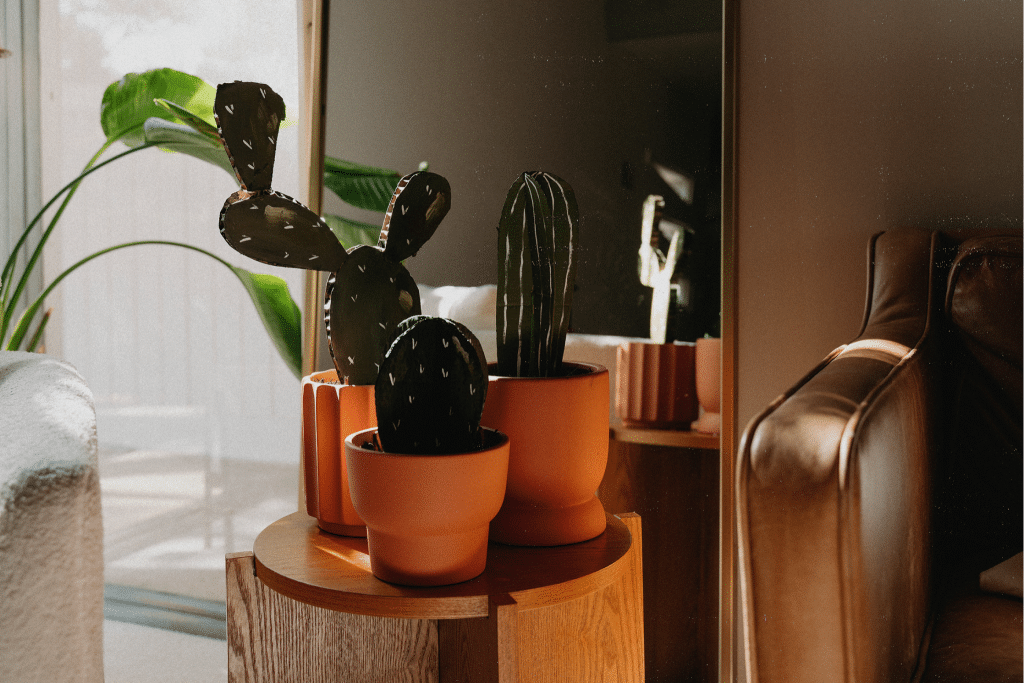As the season turns, the church ladies scurry around one morning, changing out the tapestries, the flowers, and other small details of the sanctuary. Purple for Lent and Advent, green for ordinary time, and white for Easter and Christmas.
The United States Bishops share in the book Built of Living Stones: Art, Environment and Worship, 2007, insight into the reason that we decorate our worship spaces. “The tradition of decorating or not decorating the church for liturgical seasons and feasts heightens the awareness of the festive, solemn, or penitential nature of these seasons. Human minds and hearts are stimulated by the sounds, sights, and fragrances of liturgical seasons, which combine to create powerful, lasting impressions of the rich and abundant graces unique to each of the seasons.” They continue in that “decorations are intended to draw people to the true nature of the mystery being celebrated rather than being ends in themselves.”
What if we mimicked the preparation of space in our homes? As Father Ron Rolheiser says, our homes are our domestic monasteries, and we, as families, form our own little religious communities. Our homes can bring awareness to the nature of the season that we are in. We are well versed in doing this in our homes for Advent and Christmas. Advent wreaths are placed on our kitchen tables, garlands, and bells adorn our stairwells and fireplaces. We prepare our homes for the birth of Jesus.
As we slink into Lent and then Easter, many of us don’t change any of the decorations in our homes. However, there are many easy ways that we can prepare our environments.
As a family, declutter your home on Ash Wednesday. Create visual space and quiet. The only strict rule for churches during Lent comes from the General Instruction of the Roman Missal, which states, “During Lent it is forbidden for the altar to be decorated with flowers. Exceptions, however, are Laetare Sunday (Fourth Sunday of Lent), Solemnities, and Feasts.” This is a simple rule to follow. Any artificial floral arrangements can be put away in storage, and if you love to buy fresh flowers from Trader Joe’s, use that money towards your Lenten almsgiving.
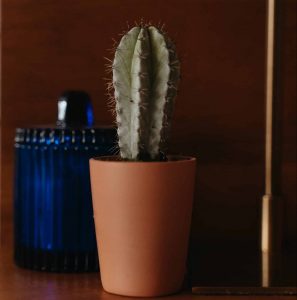
I love decorating my home with visual representations of the desert that Jesus prayed in for 40 days. Even though his desert was likely made of hills and sand with little vegetation of any kind, I like to bring other desert shrubbery into my home during Lent. You can pull in potted cacti and desert plants into your home that need little water. Set them in your prayer spaces, on shelves that you pass regularly, and on the sill by your sink to look at while you wash the dishes.
If you have small children and spiky cacti are not practical, in my book, Living the Seasons, there are instructions to make some out of cardboard and paint!
Cut some bare branches from your yard or pick up sticks on the ground and fill the vases that once held flowers. For a visual representation of the 40 days, the Waldorf Wooden Spiral is a great option.
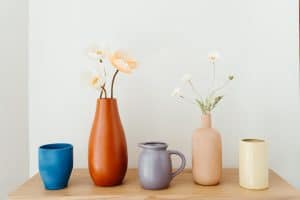
On the fourth Sunday of Lent, known as Laetare Sunday, buy some pink flowers or even make some out of tissue paper as a fun weekend activity.
On feast days such as the Annunciation of Mary, put out an icon or statue to celebrate and add a few flowers on a small altar or table. I made a simple ceramic wall altar for these moments.
The Missale Romanum allows that: “the practice of covering crosses and images in the Church from the Fifth Sunday of Lent is permitted, according to the judgment of the Conferences of Bishops. Crosses remain veiled until the end of the celebration of the Lord’s Passion on Good Friday; images remain veiled until the beginning of the Easter Vigil.”
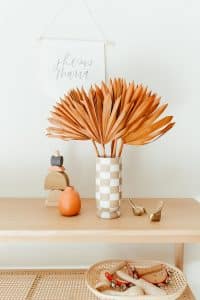
Then on Palm Sunday, replace your cacti and branches with palms to prepare for Holy Week. After the Mass of the Lord’s Supper on Holy Thursday, all crucifixes should be taken down or veiled with a simple cloth. This can also be done on the fifth Sunday of Lent, along with all visual iconography. We can easily do this in our homes. On Good Friday, after the 3 p.m. service, the crucifixes can be unveiled or replaced.
When I was living in Brazil, one of my favorite days of the year was on Holy Saturday. It is that time in between. The apostles didn’t know what was coming, but we do. So, as a community, we busied ourselves getting ready for Easter Sunday. The children I lived with had never dyed Easter Eggs, so we had so much fun with this new tradition.
This year, you could try dying eggs with natural elements. These measurements come from The Kitchn.
Per cup of water, use the following:
- 1 cup chopped purple cabbage = blue on white eggs, green on brown eggs
- 1 cup red onion skins = lavender or red eggs
- 1 cup yellow onion skins = orange on white eggs, rusty red on brown eggs
- 1 cup shredded beets = pink on white eggs, maroon on brown eggs
- 2 tablespoons ground turmeric = yellow eggs
- 1 bag Red Zinger tea = lavender eggs
Add one tablespoon of white vinegar to every cup of strained dye liquid.
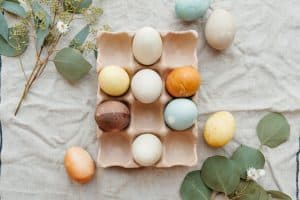
You could also use paint instead of dye. In San Antonio, which comes from the Mexican tradition, we all celebrated Easter with cascarones, which are emptied eggshells filled with confetti that you crack over people’s heads.
All of these eggs make beautiful decorations around the home.
In German culture, people decorate trees with painted Easter eggs. You can hang the eggs on the branches that decorated your home for Lent. You can also use willow twigs. The Russian Orthodox tradition uses willow twigs to represent the palms laid down before Jesus on Palm Sunday. Buy styrofoam eggs to paint with bright colors, and then attach a string at the top with a thin pin. You can leave this tree up the entire Easter season!
Another way to decorate your home for Easter is to fill it with flowers — lots of them! The Easter Lily is a traditional flower, but all kinds of colorful blooms are perfect for the occasion. We celebrate Easter for seven weeks, from Easter Sunday until Pentecost Sunday. Each week, replace the flowers to keep them fresh and joyful.
Another fun DIY for Easter decor is to refurbish used things — bring them new life! You can look around your house for what you already own — like old flower vases — or head to the thrift shop to grab a few that are new to you but need to be freshened up. Pick out spray paint from the hardware store in colors that you love and give them a fresh coat of paint. Use these vases to display your flowers!
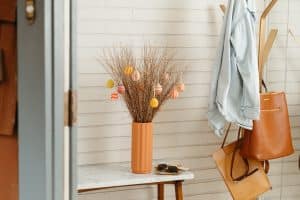
You can also put back all the decor that you took down to make space for Lent. Easter is a time for celebration, rejoicing and extravagance. Add brightly colored throw pillows or new artwork to your home for pops of joy. Find things that delight you to use in your home or as the Tik-Tok trend suggests, “dopamine decor.” As Business Insider says, “The key element behind dopamine decor is filling the house with anything colorful and fun that sparks joy, even if it all clashes aesthetically.” Dopamine decor can be our Easter inspiration.
Read more about living the liturgical seasons in Erica Campbell’s book Living the Seasons: Simple Ways to Celebrate the Beauty of Our Faith Throughout the Year.
Photos by Hannah Hoggatt.
